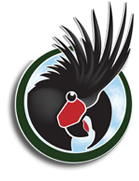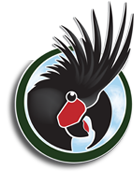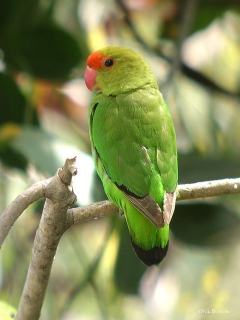Black-winged Lovebird |
|
|
Also known as: Abyssinian Lovebird
Photos
View in GalleryDid You Know?
The Black-winged or Abyssinian Lovebird is the only lovebird that uses its own feathers for its nest. Other lovebirds use twigs, leaves and other debris.Academic Research
Related publications: Agapornis tarantaSpecies Profile
Genus: Agapornis | Species: taranta
Size:
17cm (6.6 in)
Weight:
48g (1.7 oz)
Subspecies including nominate:
one
Colour Adult:
Male-mostly green; red forehead and lores; black flight feathers and underwing coverts; green lower back to upper tail coverts; green tail, the lateral feathers yellow at base and banded black near tip. Bill coral red. Feathered eye ring red. Eye dark brown. Female-green head; green underwing coverts, sometimes with black markings.
Colour Juvenile:
As in adult female, but underwing coverts black in male. Bill dusky yellow with black at base.
Call:
Calls in flight high-pitched, shrieky notes; also shrill, twittering notes.
Listen NowVideo Links:
Video 1More Information:
Content Sources:
CITES
BirdLife International
Cornell Lab of Ornithology/Birds of the World
Parrots: A Guide to Parrots of the World, Juniper and Parr, 1998
ML Media Collection Catalogue 100233, Black-winged Lovebird (Agapornis taranta), Macaulay, Linda, Ethiopia, January 9 1996, Cornell Lab of Ornithology Site
Parrots of the World, Forshaw and Cooper, 1977. 2010 edition
Parrots of the World, Forshaw, 2006.
Lexicon of Parrots, Thomas Arndt.
Parrots in Aviculture, Low, 1992.
Photos
View in GalleryDid You Know?
The Black-winged or Abyssinian Lovebird is the only lovebird that uses its own feathers for its nest. Other lovebirds use twigs, leaves and other debris.Academic Research
Related publications: Agapornis tarantaSpecies Care
Captive Status:
Uncommon in aviculture.
Longevity:
10-15 yrs
Housing:
Enclosure or aviary, indoors or outdoors, minimum length 1.2m (4 ft).
Diet:
Small seed mix such as: canary, millet and oats; hemp in cold weather; fruits such as: apple, pear, oranges if taken; green leaves such as: Swiss chard, lettuce, sowthistle, kale, dandelion, chickweed; willow catkins; spray millet; rearing food made from hard-boiled egg, wholegrain bread and carrot, all ground to crumbly consistency, given while rearing young; complete kibble for lovebirds.
Enrichment:
Vigorous chewer so provide bird-safe, unsprayed flowering, fir, pine, willow and elder branches; wooden block or vegetable tanned leather toys, heat sterilized pine cones; ladders, swings and ropes.
Nest Box Size:
Vertical box 6" x 6" x 10" (15cm x 15cm x 25.4cm).
Clutch Size:
3-4
Incubation Time:
24 days
Fledging Age:
7 weeks
Hatch Weight:
Not recorded.
Peak Weight:
Not recorded.
Weaning Weight:
Not recorded.
Photos
View in GalleryDid You Know?
The Black-winged or Abyssinian Lovebird is the only lovebird that uses its own feathers for its nest. Other lovebirds use twigs, leaves and other debris.Academic Research
Related publications: Agapornis tarantaSpecies Wild Status
World Population:
Unknown, increasing.
IUCN Red List Status:
Least Concern
CITES Listing:
Appendix II
Threat Summary:
Appears fairly widespread and more frequently seen than previously. Is found in Abijata-Shala Lakes and Bale Mountains National Parks, but elsewhere is considered a minor crop pest and is potentially exposed to risk from chemical spraying to control damage by other bird species.
Range:
Highlands of Ethiopia and S Eritrea.
Habitat:
Found from 1600-3800m (5248-12,464 ft) in highlands associated with montane forest, lower altitudes in grassy savanna and Acacia, Combretum and Hypericum woodland; also seen in cultivated and some urban areas.
Wild Diet:
Feeds on tree fruits, including Ficus figs and Juniperus berries.
Ecology and Behaviour:
Seen in small flocks outside of breeding season. Gathers in larger numbers where food abundant. Roosts communally in tree cavity, often an old woodpecker or barbet nest.
Clutch and Egg Size:
3-4 rounded eggs, 24.5 x 19.0mm (0.95 x 0.7 in)
Breeding Season:
March-November; nests are in tree cavities, holes in walls and possibly weavers' nests, lined with plant debris and feathers.
Related Links:
Research: Status of and threats to the Black-winged Lovebird...
Photos
View in GalleryDid You Know?
The Black-winged or Abyssinian Lovebird is the only lovebird that uses its own feathers for its nest. Other lovebirds use twigs, leaves and other debris.Academic Research
Related publications: Agapornis tarantaMembers Only Resources
Please log-in now to find more research, resources and tools.
Not a Member?
Find more great information:
Gain exclusive access to 600+ pages of additional research, seminars and podcasts, specialists to ask your toughest questions, and dozens of other fun resources - when you become a WPT member.
Join Today >>

































